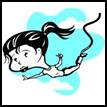题目内容
Long ago ,there lived in Greece a learned man. He was so well known for his good knowledge of almost everything that lots of people from all over the country came to learn from him. The great man taught his students whole-heartedly and answered their questions with great patience.
One day a student asked him, “ My dear teacher, didn’t you say you yourself have many ,many more questions about things than we do? But I think we students have far more than you.”
With a smile on his face, the teacher drew two circles ,one as large as a big cake, the other smaller. Then he said , “Of course, I have learned much more. But it’s wrong to think that a teacher has fewer questions than his students. Now, look at these two circles. The inside of the bigger one is my knowledge of things, and the inside of the smaller one is yours. Out of the circles is what is still unknown to us. Since mine is larger, I have to use the longer line to draw the bigger circle. That means I have more opportunities to face what is still unknown. And that’s why I myself have more questions than you do. The more you learn , the more questions you have. You will never learn enough ,you know.”
1.The learned man drew two circles to show _____.
A. he was good at drawing circles
B. his knowledge had something to do with the circles
C. why he had more questions than the students
D. how he could get more knowledge
2.The student didn’t agree that ______.
A. the teacher had so many questions as a learned man
B. the teacher had so many questions
C. the students had fewer questions than the teacher
D. the students had more questions than 0the teacher
3.The teacher was famous for his ______.
A. kindness B. knowledge C. patience D. questions
4.From the passage we can learn that_____.
A. the more questions we have, the more knowledge we may get
B. it’s never too old to learn
C. every one of us should try to be a learned man
D. a teacher should have many questions
5.Which of the following shows us what the teacher drew?

1.C
2.C
3.B
4.B
5.A
【解析】
1.理解归纳题,根据文中第三自然段的语句理解可知。
2.细节理解题,根据文中语句“didn’t you say you yourself have many ,many more questions about things than we do? But I think we students have far more than you.””理解可知。
3.细节理解题,根据文中语句“Long ago ,there lived in Greece a learned man. He was so well known for his good knowledge of almost everything that lots of people from all over the country came to learn from him.”理解可知。
4.理解归纳题,,根据文中语句理解可知。
5.细节理解题,根据文中语句“look at these two circles. The inside of the bigger one is my knowledge of things, and the inside of the smaller one is yours.”理解可知。

 名校课堂系列答案
名校课堂系列答案The peanut is a native South American plant. Scientists believe that it grew wild in Brazil long ago. They think that for several thousand years the early peoples of South America made it a part of their diet. These peoples were nomads who moved on when a natural food could no longer be found in one area. Along the way they probably let fall some peanuts, which got into the ground and grew. This is believed to be the way the plant reached the place where the Incas(印加人)lived. The Incas, from about 1100 to 1532, thought highly of peanuts. The peanuts were eaten in several forms and used as sacrificial offerings(祭品)to the Incan Sun God. Later in the 16th century, European soldiers had brought peanuts to other parts of the world, including North America, Africa, Asia, Europe, and Pacific Islands.
Although peanuts were found native in South America, they are now grown in almost every country that has warm weather. India produces the most peanuts. China’s production is next, followed by the United States.
The peanut is special in more ways than one. It can be eaten raw, boiled, roasted, or fried. Hundreds of widely different products have been made from it. Carver, an American scientist, set himself the task of discovering new uses for eating and for many other products.
Peanuts are very highly nutritious and are also high in protein (蛋白质). Americans use about seven-tenths of their protein in the form of meat. In India, where the poor can’t pay for meat or milk, peanut meal and peanut milk have been produced. These have been a great help to the poor.
New products are continually being made from peanuts, among them peanut cheese and a powder that becomes peanut butter when water is added. The fact is that peanuts are so healthy that they were used by astronauts. The unusual nut that isn’t a nut is one of nature’s most amazing gifts.
【小题1】 Although we like eating peanuts, many of us don’t know peanuts belong to _______ family.
| A.the pea | B.the nut | C.both the pea and the nut | D.neither the pea nor the nut |
| A.Paragraph Four | B.Paragraph Three |
| C.Paragraph Two | D.Paragraph One |
| A.Helpful for staying healthy. | B.Helpful to the poor. |
| C.Delicious and tasty. | D.Rich in fat and oil. |
| A.Nomads always stayed in the same place. |
| B.The peanut was first found in South America. |
| C.Astronauts ate lots of peanuts to keep healthy. |
| D.China grows fewer peanuts than the US. |
| A.To show that peanuts belong to the pea family. |
| B.To advise us to use more peanut products. |
| C.To tell us some new uses of peanuts. |
| D.To let us know more about peanuts. |
